Physical Address
304 North Cardinal St.
Dorchester Center, MA 02124
Physical Address
304 North Cardinal St.
Dorchester Center, MA 02124

Accessing power from RV outlets on battery requires specific equipment, but the freedom of off-grid camping makes it worth exploring.
You’ve probably wondered if you can run your RV’s outlets on battery power when you’re off the grid. The short answer is yes – but there’s more to it than simply plugging in your devices. Your RV’s battery system won’t power those outlets directly; you’ll need specific equipment and understanding to make it work effectively. Before you head out on your next adventure, let’s explore what it takes to keep your electronics running when you’re away from shore power.
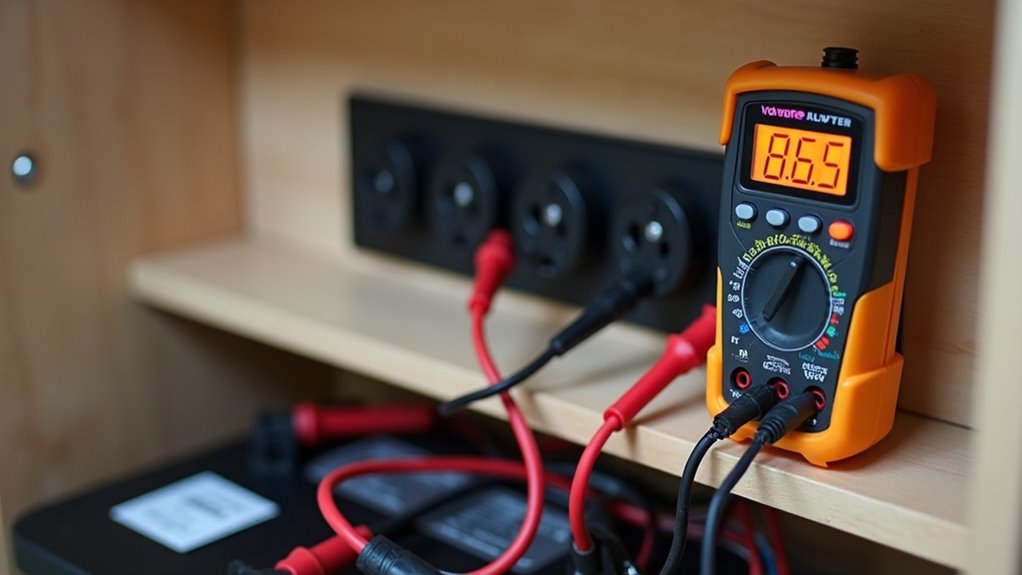
When you’re dealing with RV electrical systems, it’s important to understand the different outlet types and power sources available.
Your RV will typically have one of three main outlet configurations: a NEMA TT-30 (30 amp, 120V), a NEMA 14-50 (50 amp, 120/240V), or standard household-style outlets (15/20 amp).
The TT-30 uses three prongs and provides 120V power through a hot wire, neutral, and ground. If you’ve got a larger RV, you’ll likely have a NEMA 14-50, which offers four prongs delivering both 120V and 240V power. Using surge protection devices when connecting to any power source is essential for protecting your RV’s electrical system from damage.
RV power connectors vary from basic three-prong TT-30s to robust NEMA 14-50s, delivering either 120V or dual 120/240V service.
For smaller trailers, standard household-style outlets might be sufficient. These outlets connect to external power sources like campground pedestals or home power supplies through compatible power cords and adapters, ensuring your RV gets the right electrical feed. While plugged into shore power, your RV can function properly even with a disconnected battery, though keeping it connected provides backup power if needed.
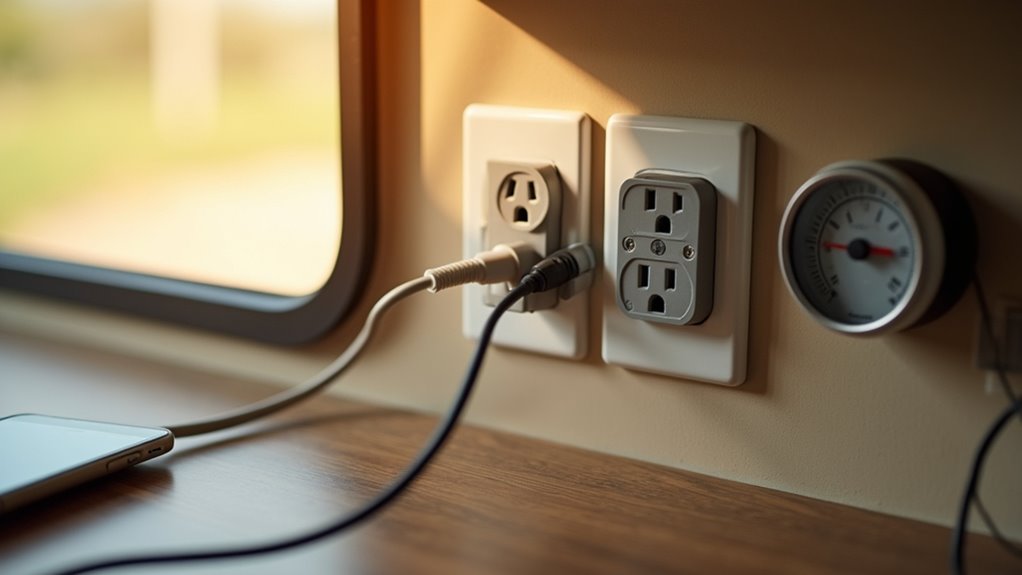
Deep cycle batteries serve as the heart of your RV’s electrical system, providing essential 12-volt power for important functions even when you’re not connected to shore power.
These batteries can be configured as single units for basic needs or multiple batteries for extended trips and larger power demands.
Your RV’s batteries charge through various methods, including shore power, generators, and solar panels.
When fully charged, they’ll measure around 13.4 volts, powering significant components like lights, water pumps, and ventilation systems.
Modern RVs often include smart charging systems that prevent overcharging and extend battery life.
For best performance, you’ll need to monitor your battery’s health and maintain proper charging levels.
Larger motorhomes might require extensive battery banks, with some configurations using up to 16 batteries to meet power demands.
Using a transfer switch helps your RV automatically switch between different power sources to maintain continuous electrical supply.
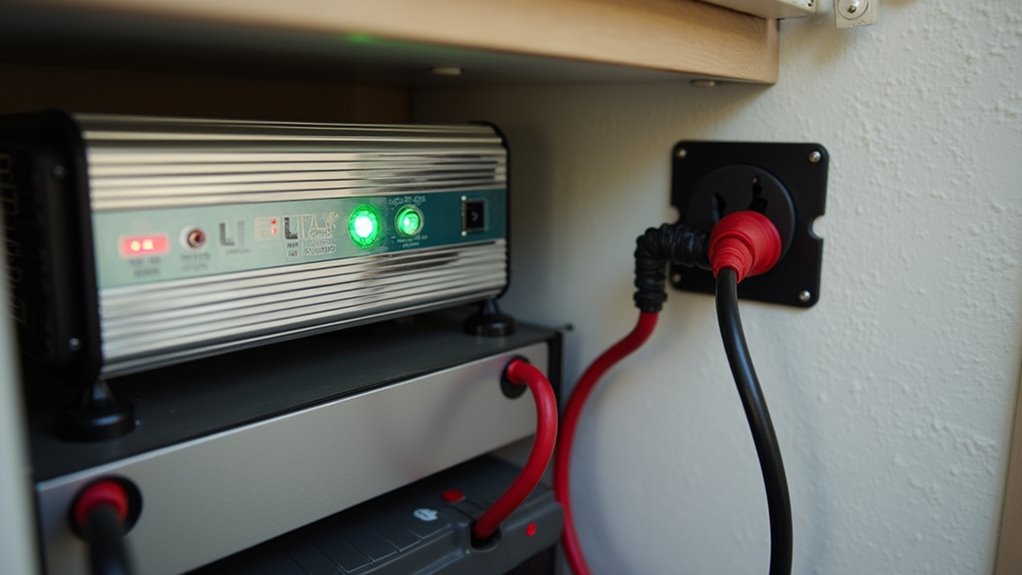
To power your RV’s AC outlets using battery power, you’ll need an inverter that converts 12-volt DC power into 120-volt AC power. This device connects between your battery and the outlet circuit, allowing you to run standard household appliances.
For basic installations, you’ll need an inverter rated for your power needs, heavy-duty wiring, and appropriate fuses or circuit breakers. Consider using a pure sine wave inverter for sensitive electronic devices. Just like maintaining your RV’s rubber roof membrane, proper inverter installation helps ensure long-term reliability.
Mount the inverter close to your battery, connect the power cables, and wire it to your selected outlets. Remember that not all RV outlets may be connected to the inverter circuit.
Choose an inverter size that matches your intended use. Small 300-watt models work for charging devices and running TVs, while larger appliances like microwaves require more powerful units.
Always monitor your battery levels and maintain proper ventilation around the inverter.
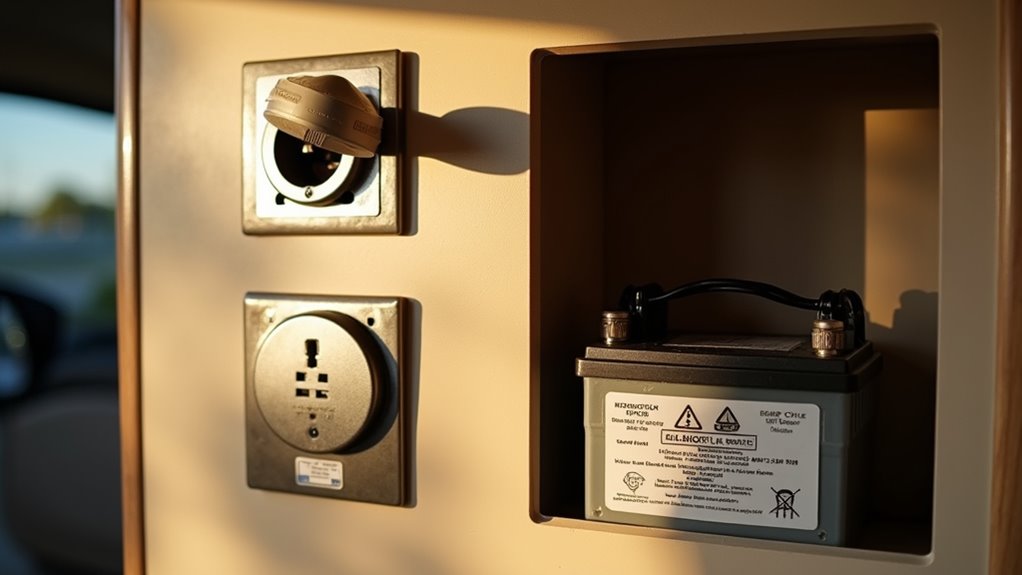
Running RV outlets on battery power comes with significant practical limitations that you’ll need to understand before relying on them.
Most standard RV battery setups can’t effectively power high-demand appliances like microwaves, air conditioners, or heaters through their outlets.
Typical RV batteries lack the power capacity needed for energy-hungry appliances, limiting their practical use for essential comfort devices.
For optimal performance and safety, inverters will typically shut off at 11V to prevent excessive battery drain.
You’ll find that even with an inverter installed, you’re limited to using low-power electronics such as laptops, phones, and LED lights.
Your battery will drain quickly when powering multiple devices simultaneously, and the inverter itself wastes 10-15% of power during DC to AC conversion.
If you’re planning to boondock, you’ll need to carefully monitor your power usage and likely supplement with solar panels or a generator.
Check appliance wattage requirements before use, and remember that exceeding your system’s capacity can damage equipment or create safety hazards.
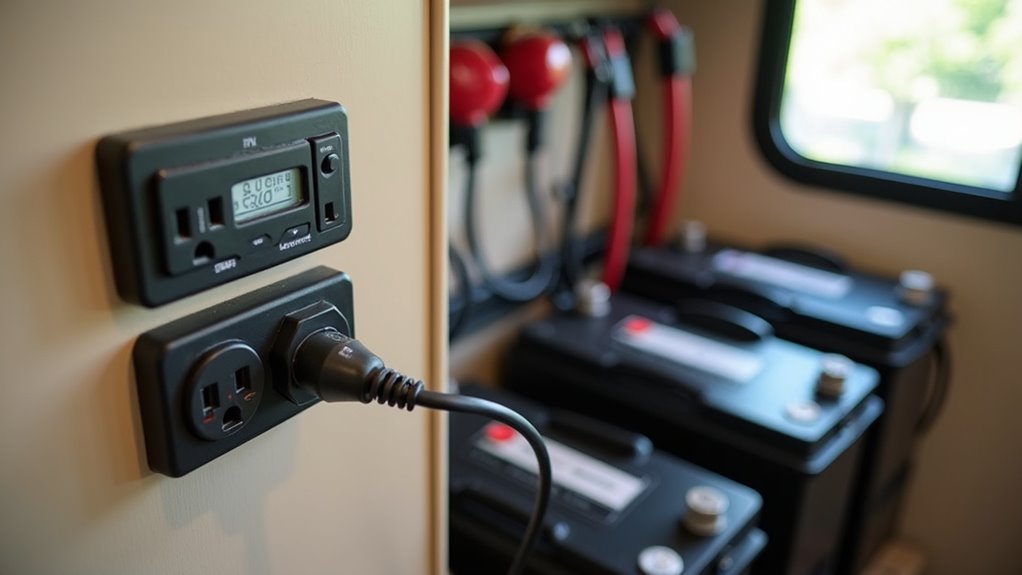
When setting up your RV’s battery-powered outlets, you’ll need several essential components working together as an integrated system. At the core, you’ll need a 12V or 24V deep cycle battery bank that provides the fundamental power source. Cold weather conditions can significantly reduce your battery’s capacity and overall performance.
An inverter is vital as it converts your battery’s DC power into 120V AC power for standard outlets.
You’ll need to incorporate proper charging systems to replenish your batteries, including solar panels with charge controllers, alternator charging, or shore power connections.
Don’t overlook safety components – install appropriate fuses, circuit breakers, and correctly sized wiring to prevent electrical hazards. A battery monitor will help you track power consumption and battery health.
For peak performance, consider adding a pure sine wave inverter, especially if you’re running sensitive electronics through your outlets.
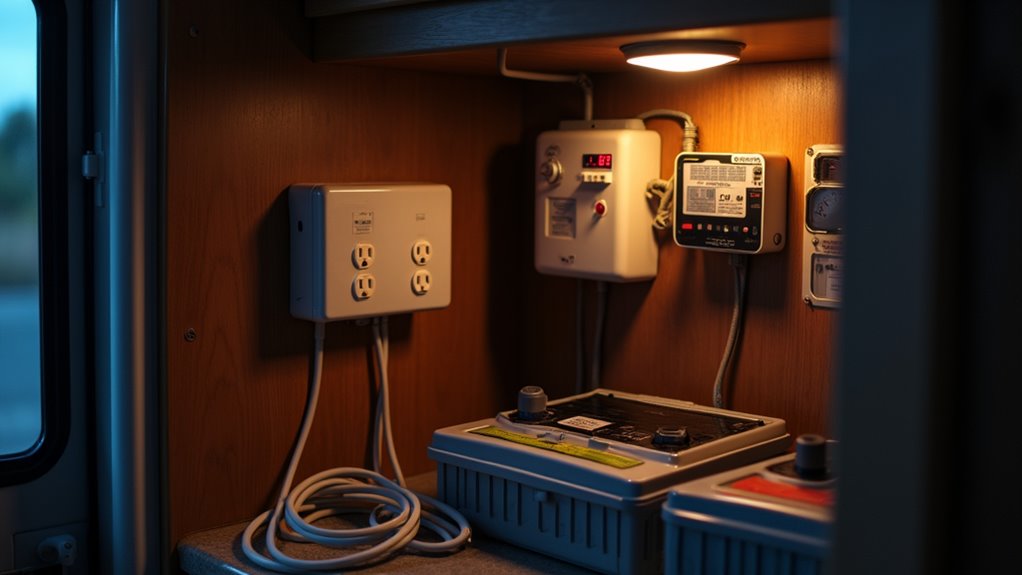
Successful battery management in your RV requires a thorough approach to power consumption and conservation. Start by evaluating your daily amp-hour usage and identifying your biggest power consumers. The refrigerator draws 5.5 amps and runs about half the day, making it one of the largest power demands.
Having a complete RV checklist ensures you have all essential power management tools and backup equipment before heading out. You’ll want to track real-time power use through battery monitors and smart control systems.
To extend battery life, maintain charge levels between 20% and 80%, and use proper charging profiles for your specific battery type.
Switch to LED lighting and Energy Star-rated appliances to reduce power draw. Unplug devices when they’re not in use to prevent phantom loads.
Install smart power management systems to automate device operation and monitor usage patterns.
Don’t forget environmental measures – use window coverings, proper insulation, and strategic parking to minimize heating and cooling demands on your battery system.
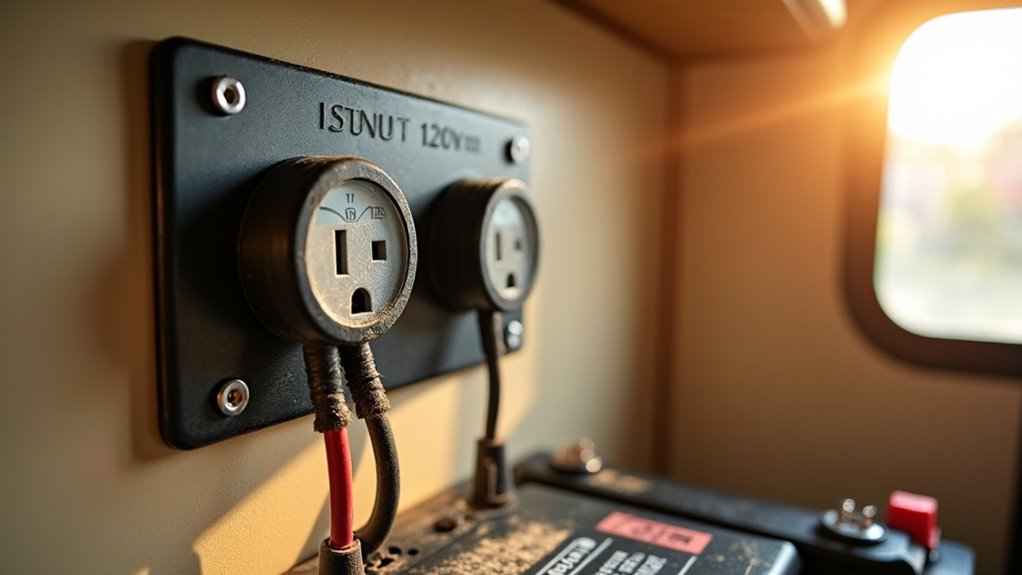
Upgrading your RV’s electrical capabilities starts with understanding the dual power systems at work – the 12-volt DC system running off batteries and the 110/120-volt AC system powered by shore power or generators.
To enhance your power availability, consider upgrading your battery bank with either lead-acid or lithium-ion batteries. Your bank can include up to 16 batteries for extended off-grid capability.
You’ll need to install a pure sine wave inverter to convert your 12-volt battery power into usable 110/120-volt AC power for your outlets. Make sure to size your inverter based on your expected power needs.
Don’t forget to verify your electrical panel can handle the increased load.
You’ll need proper circuit breakers, adequate wiring gauge, and battery disconnect switches for safety.
Installing an integrated converter/charger unit will help maintain your batteries when you’re connected to shore power.
While you’ve got outlets in your RV that’ll work on battery power, isn’t it ironic that these “convenient” power sources come with so many limitations? You’ll need an inverter, careful power management, and realistic expectations about what you can actually run. The freedom of off-grid power means you’re actually more constrained by battery capacity, forcing you to become an expert at monitoring and conserving your precious electrical resources.